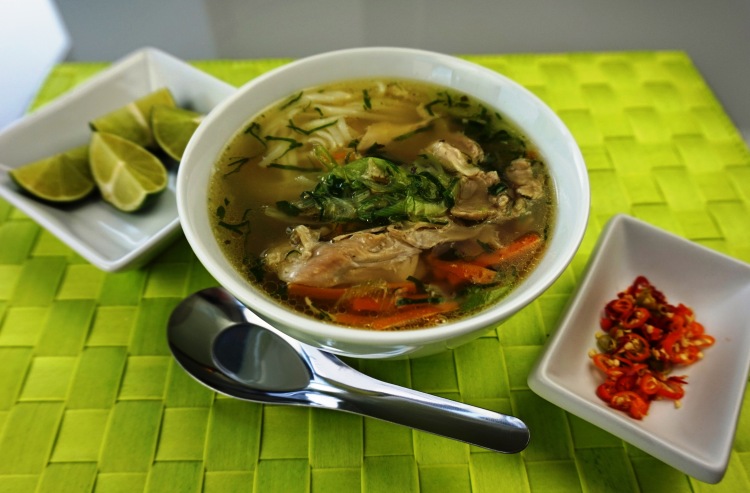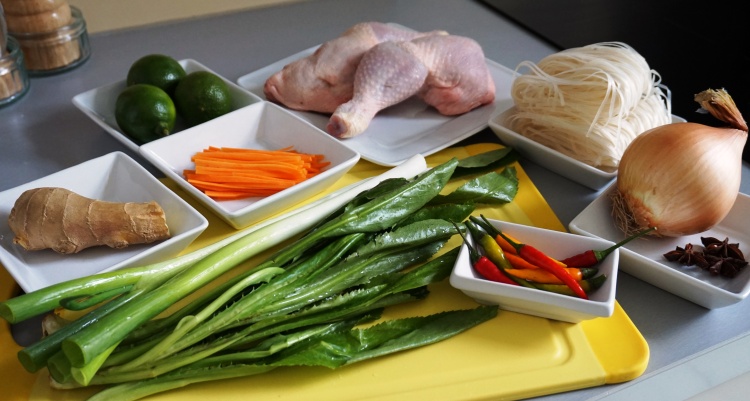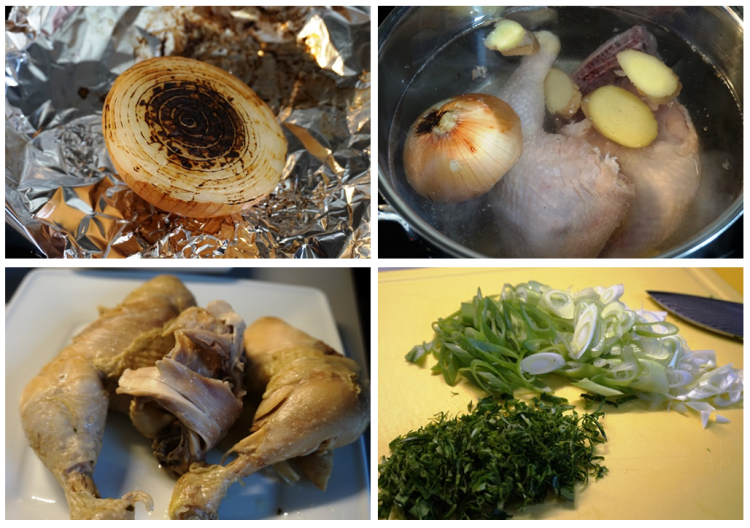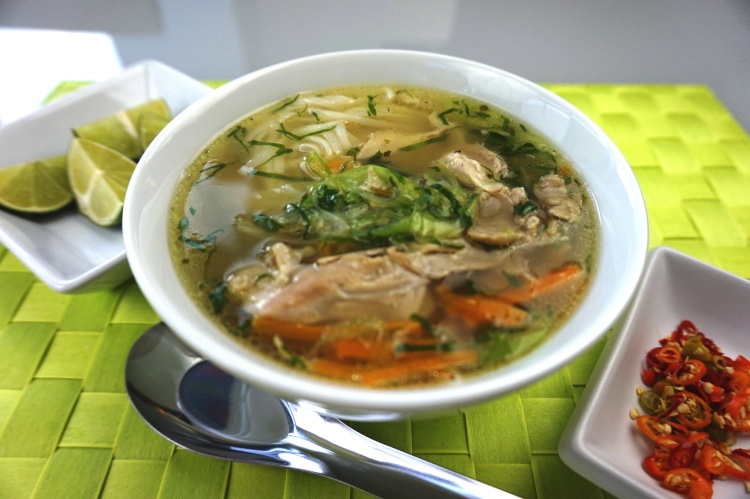Dieses Rezept habe ich von Mai, der Inhaberin meines Lieblings-Asia Shops überhaupt. Vielen lieben Dank, Mai! Eine einfache Suppe möchte man meinen, aber die Zutaten machen sie großartig: Ingwer, Sternanis und Langer Koriander, auch Lao-Koriander genannt. Mit den Reisnudeln darin, wird es eine tolle Mahlzeit. ♦ This recipe I got from Mai, the owner of my most favorite Asia-shop. Thank you very much, Mai! A simple soup it seems, but ingredients like ginger, star anise and saw leaf herb or „Farang parsley, Laotic parsley“ make it very special. Have a bowl of it with the rice noodles, and your meal is complete.
(click here for english version!)
Langer Koriander oder auch Laos-Koriander (Eryngium foetidum)
Diese besondere Form des Korianders, die deutsche Bezeichnung ist Sägeblattkraut, ist mit dem Koriander wie wir ihn kennen zwar verwandt, aber sieht zunächst einmal ganz anders aus. Seine Blätter sind lang und an den Kanten mit kleinen Sägezähnchen besetzt, sie wachsen grundständig, also alle direkt aus der Wurzel, und es gibt keine Verästelungen. Im Geschmack ist diese Sorte nochmals intensiver als der bekannte feinblättrige Koriander. Die Blätter sind sehr fest, daher sollte man sie fein schneiden.
Für die Suppe braucht es (für 2 Personen):
- 2 Hühnerbeine (für größere Mengen ein ganzes Suppenhuhn)
- Reisnudeln, mittlere breite
- 1 Gemüsezwiebel
- 3 Stück Sternanis
- Chili (für das spätere nachschärfen nach „gusto“)
- 2 Frühlingszwiebeln
- Ca. 3 cm frischen Ingwer
- Limetten
… und ich habe noch eine Karotte fein geschnitten und hinzugefügt, als zusätzliche Gemüseeinlage. Da kann man gern ein bisschen variieren, zum Beispiel gingen sicher auch ganz gut Bambussprossen.
Zur Zubereitung
Zunächst einmal wird die Gemüsezwiebel halbiert und in der Pfanne kräftig angeröstet. Dies gibt der Suppe später extra Röstaromen und auch ein bisschen mehr Farbe. Eine Alu-Folie in die Pfanne zu legen vermeidet größeren Reinigungsaufwand. Im kalten Wasser werden das Huhn, die geröstete Zwiebel und ein paar Scheiben Ingwer aufgesetzt und zum Kochen gebracht. Zwischen 20 und 30 Minuten muss die Suppe mindestens köcheln, bis das Fleisch ganz gar ist und das Huhn auch entsprechend ausgekocht. Die Möhren habe ich erst später hinzugefügt, damit sie nicht zu weich werden.
Das Fleisch wird aus der Suppe genommen, etwas abgekühlt lässt es sich dann mit einem Löffel großartig von den Knochen lösen. Die Suppe köchelt inzwischen weiter, die Karotte und der Sternanis sind jetzt hinzugefügt und simmern mit. Das Hühnerfleisch wird zerkleinert und wieder der Suppe hinzugefügt, auch die Frühlingszwiebeln und der sehr fein geschnittene Lange Koriander kommt nun hinzu. Alles zusammen sollte nun noch einmal aufwallen, und dann nochmals für 5 Minuten köcheln.
In dieser Zeit werden die Reisnudeln für etwa 4 Minuten gekocht. Sie kommen dann direkt in die Suppentasse und werden mit der fertigen Suppe mit Einlagen übergossen. In Achtel geschnittene Limetten und fein gehackte Chili dienen zum Nachwürzen nach Belieben am Tisch, absolut köstlich.
(hier klicken um zum Ende zu springen…)
Saw leaf herb or Laotic parsley (Eryngium foetidum)
This special form of Asian parsley, the german name is „Sägeblattkraut“, which translates to saw leaf herb or sawtooth herb, is related to the Asian parsley as we know it, but looks completely different. Its leaves have little saw-tooth on the sides and they are long and growing from ground, no stalks at all. In its taste this variant is even more intensive as Asian parsley. The leaves are quite firm, so you should cut them very fine.
For this soup you will need (for 2 people):
- 2 chicken legs (for bigger amounts, it would be a complete soup chicken)
- Rice noodles, middle sized
- 1 big onion
- 3 pieces of star anise
- Chili (for spicing the soup later on as you wish)
- 2 spring onions
- About 3 cm of fresh ginger
- Limes
… and I have added a carrot in fine stripes as an additional vegetable garnish. You can vary here as you like, maybe some bamboo shoots would fit in quite well too.
How to prepare
First, cut the onion in half and let it get heavily roasted in a hot pan. This will give the soup extra flavor and some color, too. To have some aluminum foil in the pan avoids bigger cleaning efforts. The chicken parts, the roasted onion and some slices of ginger are put into cold water and boiled. Let them cook together for about 20-30 minutes, depending on the size of the chicken parts. The chicken has to be completely cooked and the meat should come from the bones very easily. The carrot is added a bit later, to avoid having it cooked to soft.
Take the chicken from the soup, let it cool down a bit. The chicken meat comes off from the bones easily with a spoon. Meanwhile the soup can simmer on the oven; the carrot and the star anise are added now. Chop the chicken in smaller pieces, and put it back into the soup. Also the spring onion and the very fine cut saw leaf herb is now added. With all these in the soup, it should boil up again once and then simmer again for additional 5 minutes.
During this time the rice noodles are cooked for 4 minutes in boiling water. Put them directly to the bowl, and pour the soup with the garnish in it on top. At your table, use limes, cut in eights, and some chopped chili to adjust and spice your soup as you like, very delicious.








Sieht sehr lecker aus deine suppe ! grüsse von anja
LikeLike
Danke! Ein ganz klassisches Beispiel für die schnelle Suppe zwischendurch in Asien, am Marktstand oder Straßenverkauf… 🙂
LikeGefällt 1 Person
Looks great! Sawleaf herb is also known as sawtooth herb and Vietnamese coriander (although it tastes and smells nothing like coriander!) A lot of people don’t know about or don’t bother with toasting the onion and ginger first, but it’s essential to the flavour of the soup. Nice to see that here. Lovely presentation!
LikeLike
Thank you, yes, it was Mai to tell me that this is an important step. I knew this technique from my Grandmother for preparing soups, but wouldn’t have guessed it is used in Vietnam as well. Nice to learn about it. 🙂
LikeLike
How interesting; I didn’t know that this was a technique used in European cooking.
LikeLike